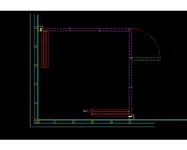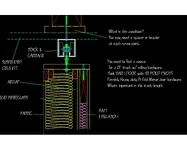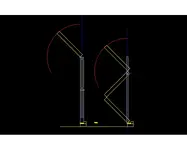Hello vanstellar and welcome to the board. Say, it would really help if you tell us more about your space. For instance, is the house exterior ALL Concrete? In the area you describe, are the two walls made of concrete in a corner, or are the parallel to each other? Is this space in a basement or ground level? On a concrete slab? What is the space for that you are seperating your proposed "isolated" space from? Are these two concrete walls part of a concrete foundation or do they support rooms above, and are other walls that inclose this space concrete as well? Give us all the info you can. Even better would be a drawing, showing the WHOLE space TO SCALE, and the two "temporary walls, and what the other walls enclosing this WHOLE space are made of.
My questions include: what would be the best/most cost effective way to construct to good sounding walls, i've heard styrofoam with some nice studio quality wedge foam over it might do the trick. also what is the best type of foam to reduce echo, usually high range.
If I'm not mistaken, you are NOT so much concerned with "soundproofing", but you want these walls to be acoustically effective, as well as removable, no?
If my assumpation is correct, then as far as building temporary partitions, YES there is a way to do this, IF certain caveats are understood, and if existing conditions allow it. Thats why I need the answers about this rooms conditions and geometry.
But no matter how you look at it, "soundproofing" is out of the question, although, if done CORRECTLY, will act as a somewhat "acoustic barrier/boundary", in as much as a one leaf, inside out boundary can. Don't expect it to perform significant transmission loss, even as well as a typical residential wall. In fact, unless MASS such as 3/4" MDF is used, and carefull attention to fabrication detail is used, these might as well be a screen door. However, the more mass, the more WEIGHT you will have to deal with. And believe me, lift a sheet of 3/4" MDF, and you will see. Plus you have to SUPPORT IT!! But since "soundproofing" is NOT a criteria, I would suggest using full sheets of 1/2" ply with full 2x4 frames, lined with 3" rigid fiberglass, and fabric stapled to the frames. Hinge panels using heavy duty hinges, and support the end with a small wheel hardware geometry that allows 1/2" clearance at the floor and 1" clearance at top for a wooden "header guide" These gaps could be "gasketed", as well as the JAMB too. You could even mount certain hardware and use one end panel as a door. However, there are LOTS of details to consider, material availability, BUDGET, tools, skills and whole lot of questions to address first.
Acoustically, these walls will perform as a broadband absorpers , and if bass trapping is added at corners, these could extend the absorption of low frequencies , and this COULD be a very flexible recording space. But only if we know the facts.... as Sgt. Friday says....'just the facts mam"

Here is an example of what I am talking about. Even the two existing "drywalls" over concrete will perform as membrane traps, IF, the airgap between the drywall and the concrete is AIRTIGHT, and the cavities are lined with batt type insulation. IF the studs are at 24" on center approx, you have "built in" low frequency absorption to a degree. As a "hinged" option, 12 feet in length is about the maximum, as 48"x(room height) is about as large as you can make one panel, and as a TRI FOLD assembly, thats about the maximum length total you will get. You would also have to mount the "jamb", where an existing stud is in the furred out wall.
Other than that, your only "removable" options are removable "hanging" panels, which have their set of problems, although the overall length of a wall is only limited by the support from above. However, hanging ONE 3/4" thick MDF panel could be.......lets just say, "challanging"...let alone 3. Not that fabricating a tri fold system is easy. Quite the contrary. Any of these type projects take SKILL and forethought. Not to mention a small budget.
Well, thats all I have time for right now. If this isn't an option, well, good luck with your plan. However, if it is let me know and I'll post some details. BTW, what is your ceiling HEIGHT and is it consistant?
fitZ

 Rigid fiberlass will have foam....foam what?.......I don't get it
Rigid fiberlass will have foam....foam what?.......I don't get it Here is an example of what I am talking about. Even the two existing "drywalls" over concrete will perform as membrane traps, IF, the airgap between the drywall and the concrete is AIRTIGHT, and the cavities are lined with batt type insulation. IF the studs are at 24" on center approx, you have "built in" low frequency absorption to a degree. As a "hinged" option, 12 feet in length is about the maximum, as 48"x(room height) is about as large as you can make one panel, and as a TRI FOLD assembly, thats about the maximum length total you will get. You would also have to mount the "jamb", where an existing stud is in the furred out wall.
Here is an example of what I am talking about. Even the two existing "drywalls" over concrete will perform as membrane traps, IF, the airgap between the drywall and the concrete is AIRTIGHT, and the cavities are lined with batt type insulation. IF the studs are at 24" on center approx, you have "built in" low frequency absorption to a degree. As a "hinged" option, 12 feet in length is about the maximum, as 48"x(room height) is about as large as you can make one panel, and as a TRI FOLD assembly, thats about the maximum length total you will get. You would also have to mount the "jamb", where an existing stud is in the furred out wall.



